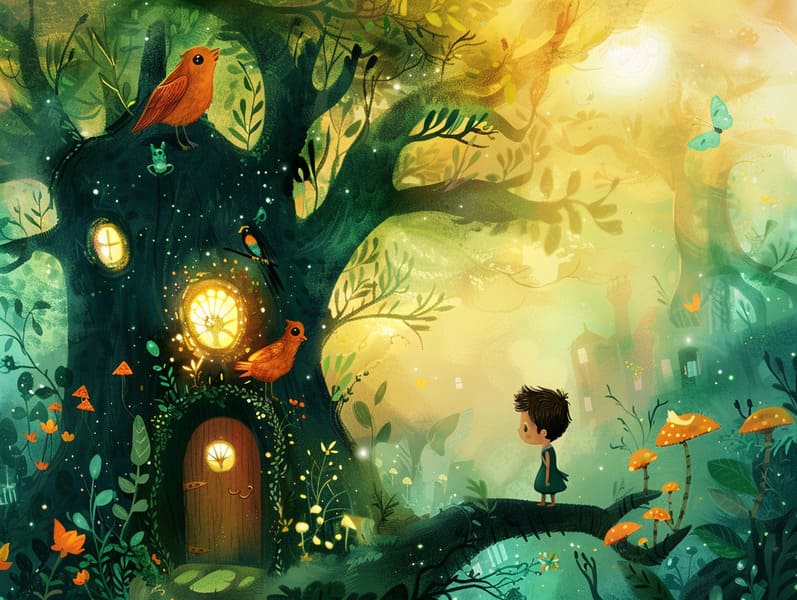
Evening is a cherished time for kids and their parents. It’s a ritual to unwind, huddle together, and delight in the enchantment of stories.
For generations, stories for kids at bedtime have been a treasured habit, offering more than just a way to slumber. They provide an opportunity for affection, education, and sparking vision.
How Bedtime Stories Help
Nightly tales for children serve more than a way to finish the day. They play a crucial role in a child’s evolution and in nurturing the adult-child bond. Here’s why they are valuable:
1. Closeness Moments: Nightly storytelling encourages a special period of closeness between families. It’s a moment of proximity that helps children feel important and content.
2. Language Development: Experiencing stories helps children develop their language acquisition. They pick up new expressions, understand construction, and boost their comprehension and grasping abilities.
3. Imaginative Skills: Nightly stories move them to fantastic worlds, stimulating inventiveness. They picture characters, settings, and adventures, which sparks their creative thinking.
4. Emotional Growth: Stories for little ones often depict characters facing issues and states. These scripts help kids grasp and deal with their own moods, building feeling recognition.
5. Thinking Skills: Absorbing a narrative helps children develop awareness, memory, and logical thinking. They develop to follow tales, remember aspects, and project conclusions.
Including Bedtime Stories in Your Routine
Developing a night-time practice that includes narrating bedtime stories is manageable and worthwhile. Here’s how to make it a important part of your end-of-day ritual:
1. Find a Cozy Place: Identify a peaceful place where you and your child can get cozy without interruptions. A relaxing bed or a snug reading nook works great.
2. Set a Regular Time: Establish a routine time each night for bedtime reading. Regularity helps children predict and makes the routine more manageable.
3. Choose Age-Fitting Stories: Identify tales that fit your child’s developmental stage. Toddlers might be engaged by illustrated books with basic stories, while grown children may enjoy complex plots with more complicated tales.
4. Get Involved with the Story: Ensure the tale become real by employing different voices and accents, adding noises, and asking your child to be active. Ask stuff about the story to hold their attention.
5. Set a Tranquil Atmosphere: Reduce the lights, use quiet tones, and create a tranquil environment to help your child relax.
Finding Quality Bedtime Stories
There are abundant sources where you can find great bedtime stories for children. Here are some places to check out:
1. Books for Kids: Visit your local library or bookstore to find a large selection of bedtime stories for kids. Checking out the choices together can be a wonderful activity that also lets children to find stories that interest them.
2. Online Resources: There are many websites that offer free bedtime stories. Sites like Storyberries provide a variety of short stories for kids that you can download. These resources are great for finding new and varied stories without fees.
3. Apps for Storytelling: For nights when you’re too tired to read, try audiobooks or storytelling apps. These can provide a quiet narration to read your child a story, ensuring they still get their bedtime story fix. Apps often offer interactive parts that can keep kids interested further.
4. Tailored Stories: Create your own stories based on your child’s passions. Personalized stories can be highly engaging and meaningful. You can incorporate your child in the development process, making them a part of the adventure.
Shorter Story Benefits
Quick stories for bedtime are highly advantageous for bedtime. They provide all the benefits of longer stories but are more brief, making them perfect for preparing for sleep before sleep. Here’s why short stories are a wonderful choice:
1. Easy to Follow: Short stories are direct and understandable for kids, even after a long day. They can readily grasp the theme and enjoy the story without becoming uninterested.
2. Immediate Attention: Concise stories promptly engage children, holding their engagement and imagination. This makes them perfect for keeping bedtime practices easy yet enjoyable.
3. Diverse Options: Concise narratives offer for variety in your bedtime tales. You can select a different story each night, keeping the practice new and exciting for your child.
4. Time-Saving: For busy parents, to-the-point tales are a fast way to make sure children still get their nightly dose of storytelling. They fit well into a crowded schedule while still offering the full good points of a bedtime story.
The Delight of "Read Me a Story"
The simple phrase, “Read me something,” can bring a world of magic for children. Agreeing to this request not only caters to a child’s requirement for attention and engagement but also establishes lasting occasions. Here’s why it’s charming:
1. Link: Reading to your child here fosters a deep emotional tie. It’s a time for proximity, sharing, and bonding.
2. Tradition: Building a bedtime story ritual creates a important tradition that children wait for every night. It’s a ritual that can be transferred through generations.
3. Shared Learning: As you read, you’ll see your child’s growth and maturation. Their interest, reactions, and understanding of the stories develop, offering insights into their developing minds.
4. Safe Space: Bedtime stories provide a safe space for children to examine emotions, face fears, and find comfort in the recognizable presence of a parent.
The Last Word
Nightly tales for children are a valuable tool for growing a child’s maturation and establishing unforgettable memories of togetherness.